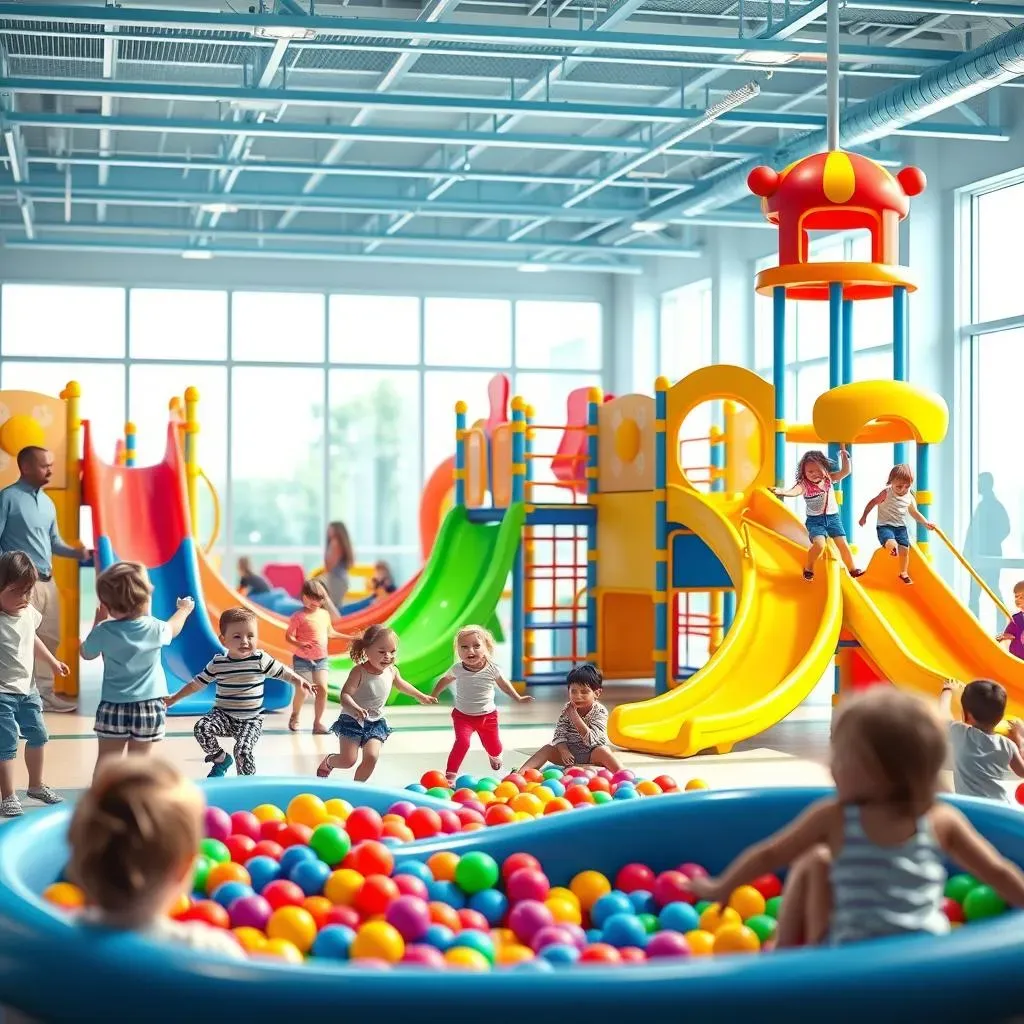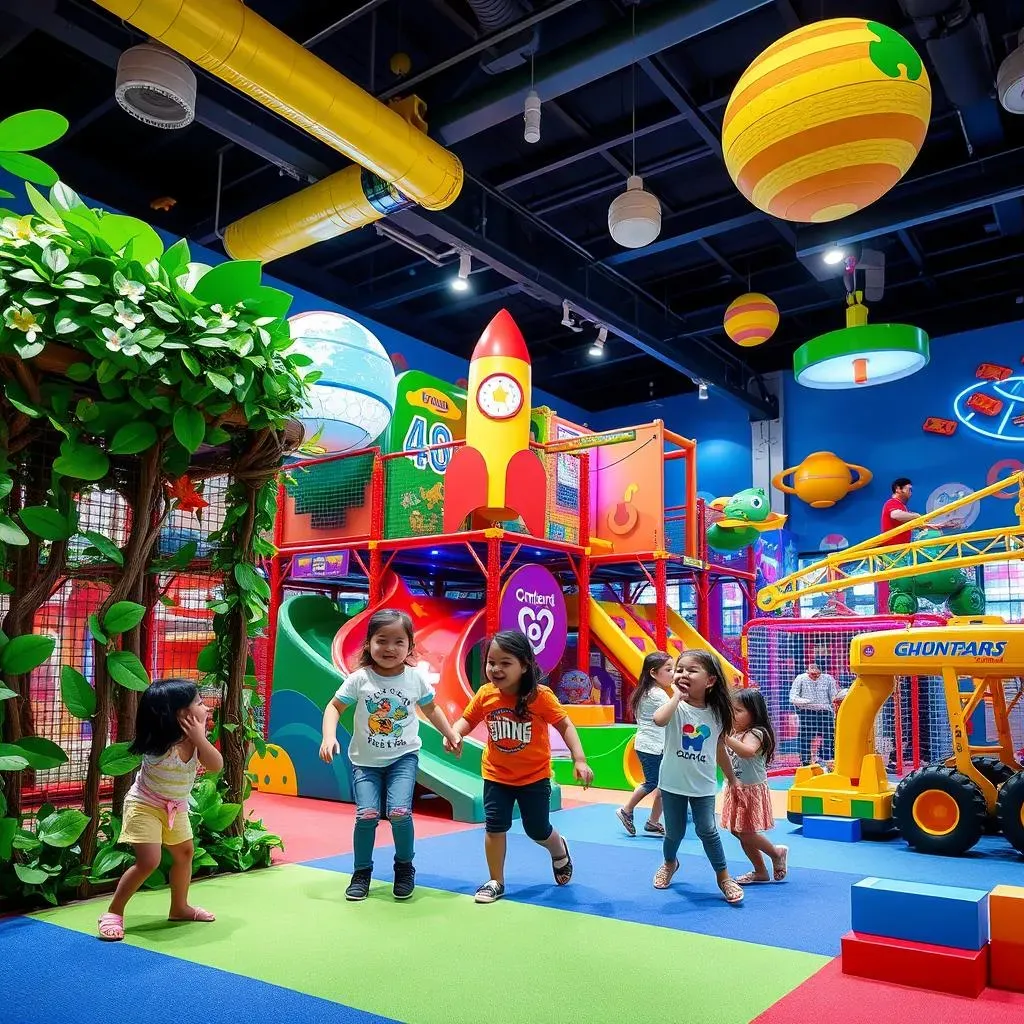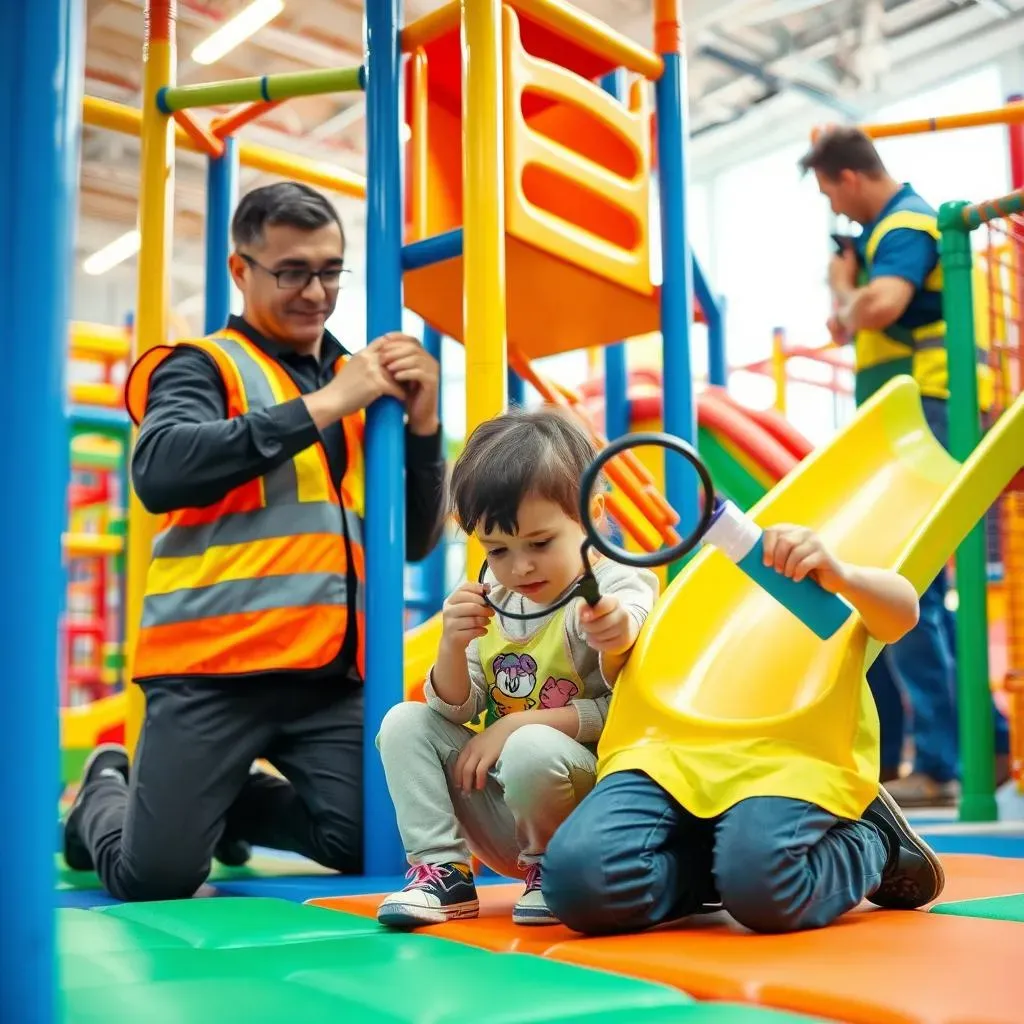Table of Contents
Creating a fun and safe indoor play area for kids starts with choosing the right indoor play equipment manufacturers. But with so many options out there, how do you make the best decision? This guide cuts through the noise, offering a clear path to selecting manufacturers that prioritize quality, safety, and innovation. We'll explore the crucial factors to consider, from understanding safety standards and certifications to navigating customization options that bring your unique vision to life. Plus, we'll share essential tips on installation and maintenance to ensure your play area remains a source of joy for years to come. Whether you're designing a play space for a family entertainment center, a school, or even your own home, this article equips you with the knowledge to partner with the ideal indoor play equipment manufacturers and create an environment where kids can thrive.
Choosing the Right Indoor Play Equipment Manufacturers

Choosing the Right Indoor Play Equipment Manufacturers
so you're diving into the world of indoor play equipment! That's awesome. First things first: choosing the right indoor play equipment manufacturers isn't just about finding the flashiest slides or the coolest climbing structures. It's about partnering with a company that understands your vision, prioritizes safety above all else, and can deliver a product that lasts. Think of it like building a house – you wouldn't hire just any contractor, right? You'd want someone with a solid reputation, proven experience, and a commitment to quality. The same goes for play equipment. You need a manufacturer that's reliable, innovative, and genuinely cares about creating a safe and engaging environment for kids.
Key Considerations When Selecting Indoor Play Structures

Key Considerations When Selecting Indoor Play Structures
Space and Dimensions
Alright, so you've got your eye on some awesome indoor play structures. Before you get too carried away, let's talk about space. I cannot stress this enough: measure, measure, measure! You need to know the exact dimensions of your play area – length, width, and, most importantly, height. Don't just eyeball it! Account for any obstructions like columns, low ceilings, or oddly placed outlets. You'd be surprised how many people skip this step and end up with a play structure that doesn't quite fit. Imagine the frustration! Get those measurements down, and then start browsing with those numbers in mind. Also, think about the flow of traffic around the structure. You don't want kids bumping into walls or each other.
Think about creating different zones within your play area. A quiet reading nook, an active climbing zone, and maybe a creative building area. This helps cater to different interests and energy levels. Consider the age range of the kids who will be using the structure. A toddler area will need different features than a play area for older children. This is all part of smart space planning!
Safety First, Always
Now, let's dive into the non-negotiable: safety. When selecting indoor play structures, safety should be your absolute top priority. I'm talking about things like proper padding, secure connections, and materials that are free from harmful chemicals. Check for certifications like ASTM or EN standards – these indicate that the equipment has been tested and meets specific safety requirements. Don't be afraid to ask the manufacturer for documentation and test results. It's your right to know that the equipment you're buying is safe for kids. Pay close attention to the height of platforms and slides, and make sure there are adequate safety barriers in place. Regularly inspect the equipment for any signs of wear and tear, and address any issues promptly.
Think about the surfacing under and around the play structure. You'll want something soft and impact-absorbing, like poured-in-place rubber, safety tiles, or engineered wood fiber. This will help cushion falls and prevent injuries. Also, make sure the play area is well-lit and free from any tripping hazards. A safe play area is a fun play area!
Safety Feature | Description | Why It Matters |
|---|---|---|
Padding | Soft, impact-absorbing materials covering hard surfaces | Reduces the risk of injuries from falls |
Secure Connections | Strong, reliable fasteners that hold the structure together | Prevents the structure from collapsing or becoming unstable |
Non-Toxic Materials | Materials that are free from harmful chemicals | Protects children from exposure to toxins |
Durability and Materials
so you've got the space sorted and you're laser-focused on safety. Now, let's consider the long game: durability and materials. You want indoor play structures that can withstand the test of time (and a whole lot of energetic kids!). Look for manufacturers who use high-quality materials like durable plastics, powder-coated metal, and sustainably sourced wood. These materials are not only strong and long-lasting, but they're also easy to clean and maintain. Ask about the warranty offered by the manufacturer – a good warranty is a sign that they stand behind their product. Think about the climate in your area. If you live in a humid environment, you'll want to choose materials that are resistant to moisture and mildew. And if you're planning on placing the play structure near a window, make sure the materials are UV-resistant to prevent fading.
Consider the overall design of the play structure. Look for features that will encourage kids to be active and engaged. Climbing walls, slides, tunnels, and interactive games are all great options. But don't just focus on the physical aspects of the play structure. Think about the social and emotional benefits as well. A well-designed play area can help kids develop important skills like teamwork, communication, and problem-solving. When you invest in durable, well-designed play equipment, you're investing in the future of your kids.
Safety Standards and Certifications for Indoor Play Equipment

Safety Standards and Certifications for Indoor Play Equipment
Understanding the Importance of Safety Standards
let's get serious about safety – because when it comes to kids, there's no room for compromise. Safety standards and certifications for indoor play equipment are your best friends in ensuring a secure play environment. These aren't just fancy labels; they're the result of rigorous testing and evaluation to minimize risks and prevent injuries. Think of them as a seal of approval, indicating that the equipment meets specific safety requirements. Ignoring these standards is like playing Russian roulette – you might get away with it, but the consequences can be devastating. Always prioritize equipment that has been certified by reputable organizations.
Understanding these standards helps you make informed decisions. It's not just about ticking a box; it's about understanding what the certifications mean and how they protect children. It's about creating a culture of safety where everyone – from the manufacturer to the end-user – is committed to providing a secure play environment. So, let's dive into some of the key safety standards and certifications you should be aware of.
Key Safety Certifications to Look For
So, what are these key certifications I keep mentioning? Let's break it down. Some of the most important ones to look for include ASTM (American Society for Testing and Materials) standards, EN (European Norm) standards, and certifications from organizations like TÜV SÜD or UL. These certifications cover a wide range of safety aspects, from the materials used in construction to the structural integrity of the equipment. They ensure that the equipment has been tested for things like impact resistance, flammability, and the presence of harmful chemicals. Don't be shy about asking manufacturers for proof of certification – any reputable company will be happy to provide it.
Think of these certifications as a safety net. They're there to catch any potential problems before they can cause harm. They provide an extra layer of assurance that the equipment you're buying is safe and reliable. When you see these certifications, you can rest a little easier knowing that you've done your due diligence in protecting the children in your care.
How to Verify and Maintain Safety Compliance
Alright, you've found equipment with the right certifications – great! But the job doesn't end there. It's crucial to verify that the certifications are valid and up-to-date. Check the certification labels on the equipment and compare them to the documentation provided by the manufacturer. If anything seems fishy, don't hesitate to contact the certifying organization directly to confirm the validity of the certification. And remember, safety is an ongoing process. Regularly inspect your indoor play equipment for any signs of wear and tear, and address any issues promptly. Keep a log of your inspections and maintenance activities to ensure that you're staying on top of things. After all, a safe play area is a happy play area!
Training your staff on proper safety procedures is also essential. Make sure they know how to identify potential hazards and how to respond in case of an emergency. Conduct regular safety drills to keep everyone prepared. And don't forget to involve the children in safety education as well. Teach them how to use the equipment properly and how to recognize potential dangers. By working together, you can create a culture of safety that protects everyone.
Step | Description | Importance |
|---|---|---|
Verify Certifications | Check labels and documentation against certifying organization records | Ensures certifications are valid and not fraudulent |
Regular Inspections | Conduct routine checks for wear, damage, or hazards | Identifies potential safety issues early |
Maintenance | Promptly repair or replace damaged equipment | Prevents minor issues from becoming major safety risks |
Customization Options from Leading Manufacturers of Indoor Play Equipment

Customization Options from Leading Manufacturers of Indoor Play Equipment
Alright, let's talk about the fun part: customization! With leading indoor play equipment manufacturers, the sky's the limit when it comes to creating a truly unique and engaging play space. I'm not just talking about picking a few different colors here and there. We're talking about designing a play structure that perfectly fits your space, your budget, and your vision. Think of it like commissioning a piece of art – you get to collaborate with the artist (in this case, the manufacturer) to create something that's truly one-of-a-kind. Whether you want to incorporate your company's logo, create a themed play area, or design a structure that caters to specific age groups or abilities, customization options allow you to create a play space that's as unique as the kids who will be using it.
Consider adding interactive elements to your play structure, like sound effects, light displays, or digital games. These features can help to engage children's senses and keep them entertained for hours. And don't forget about the importance of accessibility. Make sure your play structure is designed to be inclusive of children with disabilities. Ramps, wider pathways, and sensory-rich elements can help to create a play space that's welcoming to everyone. When you embrace customization, you're not just creating a play area; you're creating an experience.
Themed Play Areas
Want to transport kids to a jungle, outer space, or a pirate ship? Themed play areas are a fantastic way to spark their imaginations and create a truly immersive play experience. Work with your manufacturer to incorporate elements like custom graphics, themed props, and unique architectural features that bring your vision to life. Imagine a castle-themed play area with turrets, moats, and a drawbridge. Or a space-themed play area with rockets, planets, and a control panel. The possibilities are endless!
Think about the educational opportunities that themed play areas can provide. A museum-themed play area can teach kids about history, art, or science. A nature-themed play area can teach them about plants, animals, and the environment. By incorporating educational elements into your play area, you can help to make learning fun and engaging. Themed play areas are not just about aesthetics; they're about creating a rich and meaningful play experience.
Theme Idea | Example Elements | Educational Opportunities |
|---|---|---|
Jungle | Vines, animal sculptures, rope bridges | Learn about different animal species and habitats |
Outer Space | Rockets, planets, control panels | Learn about astronomy and space exploration |
Construction Site | Cranes, bulldozers, building blocks | Learn about engineering and construction |
Custom Colors and Branding
Don't underestimate the power of color! Custom colors and branding can help to create a play area that's visually appealing and consistent with your overall brand identity. Work with your manufacturer to choose colors that are bright, cheerful, and inviting. Consider incorporating your company's logo or mascot into the design of the play structure. This can help to reinforce your brand and create a sense of familiarity for kids and parents.
Think about the psychology of color. Different colors can evoke different emotions and create different moods. Blue is often associated with calmness and serenity, while yellow is associated with happiness and energy. Choose colors that are appropriate for the type of play experience you want to create. And don't be afraid to experiment with different color combinations. A well-designed color scheme can make your play area stand out from the crowd.
Installation and Maintenance Tips for LongLasting Indoor Play Areas

Installation and Maintenance Tips for LongLasting Indoor Play Areas
Professional Installation is Key
So, you've chosen your indoor play equipment – fantastic! But don't just throw it together yourself with a YouTube tutorial and a wrench. Trust me, investing in professional installation is worth its weight in gold. I know it can be tempting to save a few bucks, but improper installation can lead to serious safety hazards down the line. We're talking about wobbly structures, loose connections, and potential collapses. A professional installer will have the expertise and equipment to ensure that everything is assembled correctly and securely, according to the manufacturer's specifications. Think of it as an investment in peace of mind – you'll sleep better knowing that your play area is safe for kids.
Plus, professional installers often have experience working with a variety of different play equipment brands and models. They'll be familiar with the specific challenges and requirements of each installation, and they'll be able to troubleshoot any problems that may arise. They'll also be able to advise you on the best placement of the equipment to maximize safety and play value. When you hire a professional installer, you're not just paying for their labor; you're paying for their expertise and experience.
Regular Inspection and Cleaning
the equipment's installed, the kids are having a blast – now what? Don't fall into the trap of thinking your job is done! Regular inspection and cleaning are crucial for maintaining the safety and longevity of your indoor play areas. I'm talking about a weekly or even daily check for any signs of wear and tear, like loose bolts, frayed ropes, or cracked padding. Address any issues promptly – a small problem can quickly turn into a big one if left unattended. And don't forget about cleaning! Regular cleaning helps to prevent the spread of germs and bacteria, and it also keeps your play area looking fresh and inviting. Use a mild soap and water solution to wipe down surfaces, and pay special attention to high-touch areas like handrails and slides.
Think about creating a checklist for your inspections and cleaning activities. This will help you stay organized and ensure that you're not missing anything. Assign responsibility for inspections and cleaning to specific staff members, and make sure they're properly trained on what to look for and how to address any issues. And don't forget to document your activities. Keeping a log of your inspections and cleaning will help you track trends and identify potential problems before they become serious. Regular inspection and cleaning are not just about maintaining the appearance of your play area; they're about protecting the health and safety of the children who use it.
Task | Frequency | Description |
|---|---|---|
Visual Inspection | Daily/Weekly | Check for loose bolts, frayed ropes, cracked padding, or other signs of wear and tear |
Surface Cleaning | Weekly/Monthly | Wipe down surfaces with a mild soap and water solution |
Deep Cleaning | Quarterly/Annually | Thoroughly clean and disinfect all areas of the play structure |
Preventative Maintenance and Repairs
So, you're inspecting and cleaning regularly – awesome! Now, let's talk about preventative maintenance and repairs. This is where you take proactive steps to prevent problems before they occur. I'm talking about things like lubricating moving parts, tightening bolts, and replacing worn-out components. Refer to the manufacturer's maintenance guidelines for specific recommendations on how to care for your indoor play equipment. And don't be afraid to call in a professional for more complex repairs. Trying to fix something yourself without the proper knowledge or tools can often do more harm than good.
Think about creating a budget for preventative maintenance and repairs. This will help you ensure that you have the resources available to address any issues that may arise. And don't wait until something breaks down completely before taking action. Addressing minor problems early can prevent them from turning into major (and more expensive) repairs down the line. Preventative maintenance and repairs are not just about saving money; they're about extending the lifespan of your play equipment and ensuring that it remains safe and enjoyable for years to come.
Conclusion: Building a Brighter Future Through Play
Selecting the right indoor play equipment manufacturers is an investment in children's health, development, and happiness. By prioritizing safety, quality, and customization, you can create a play area that fosters creativity, social interaction, and physical activity. Remember to thoroughly research potential manufacturers, understand safety standards, and plan for proper installation and maintenance. With careful consideration, your indoor play area will become a cherished space where children can learn, grow, and make lasting memories.